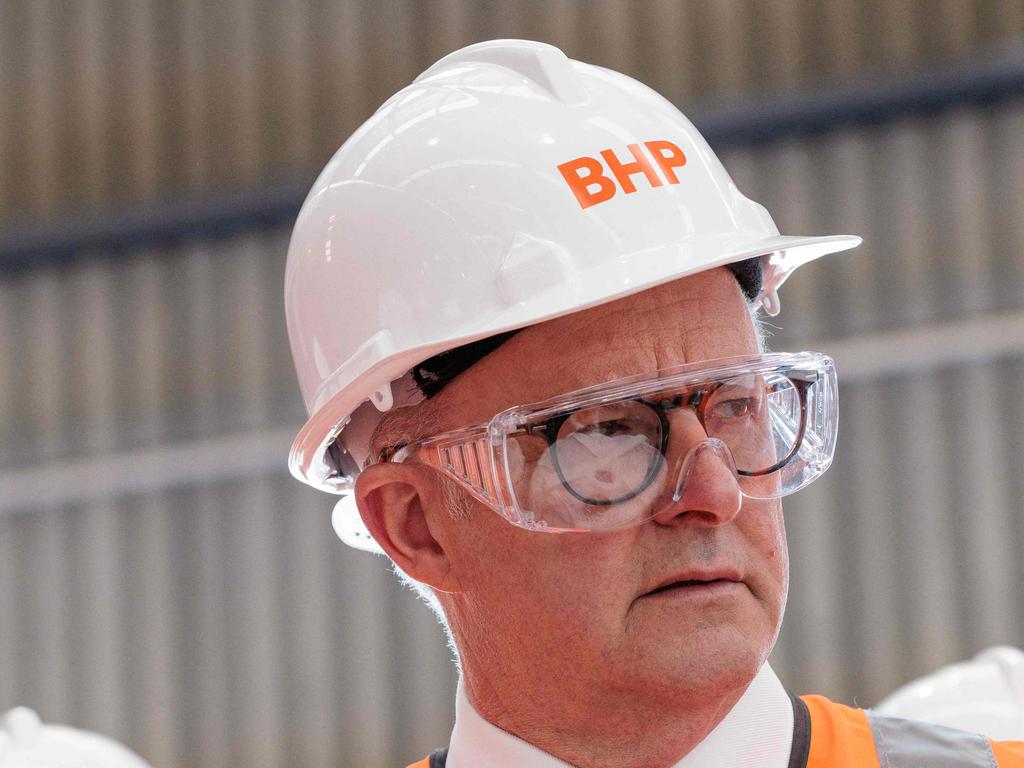BHP profit drops on nickel, Samarco Dam disaster charges
Nickel has become the thorn in BHP’s side, but the company’s ever-reliable iron ore division has again delivered a bumper profit.

BHP said it expects costs to lift in the second half of the financial year as inflation flows through into its long-term contracts, with the company to pay a reduced US72c a share dividend as it reinvests in its global commodities business.
BHP’s statutory net profit slumped 86 per cent slump to $US927m ($1.42bn) for the first half of the year on the back of massive one off charges in Australia and Brazil, but the company’s underlying attributable profit of $US6.6bn was broadly in line with the first half of the previous financial year.
BHP last week flagged it would take more than $US5.7bn in one-off charges against its accounts, on an after tax basis, as it wrote off the entirety of its Nickel West assets and took a $US3.2bn income statement charge in relation to the Samarco Dam disaster.
The Samarco charge relates to the January decision of a Brazilian court to quantify the “moral damages” portion of a 155 billion Brazilian real claim by authorities in the country, with the court ruling BHP and Vale should pay 47.6 billion Brazilian real ahead of any determination on the rest of the lawsuit.
The company said the charge reflects “potential future outflows” to resolve the Brazilian prosecution, as well as its existing obligations under a framework agreement set shortly after the 2015 collapse of the Samarco tailings dam.
BHP booked underlying earnings before interest, tax, depreciation and amortisation of $US13.9bn, and underlying earnings before interest and tax of $US11.23bn.
Chief executive Mike Henry said the nickel and Samarco charges had undermined a “solid operational performance and overall healthy commodity prices”.
“At our Western Australia Iron Ore operations, we remain the lowest cost major producer globally and in copper we set new production records at our operations in South Australia and Chile. In South Australia, our consolidated copper province has performed strongly, and we are pursuing future growth options,” he said.
“We’ve seen volatility in global commodity prices and demand in the developed world has been softer than expected. That said, China demand is healthy despite weakness in housing and India remains a bright spot.”
Analyst consensus estimates had tipped underlying EBITDA for the first six months of the year at $US13.87bn, with underlying EBIT at $US11.06bn. Analyst consensus had expected a US69c a share interim dividend.
But, while BHP made a point of noting it had kept average unit cost inflation to 5.3 per cent for the first half of the year, well below the 6.3 per cent average inflation rate across the global jurisdictions in which it operates, the company warned it still faces a labour and other cost pressures.
“We expect the lagged impact of global inflation to continue into the second half, particularly in relation to labour, and as we negotiate long-term supply arrangements,” the company said.
“We continue to assess the impact of the Australian federal government’s ‘Same Job Same Pay’ industrial relations reforms which will add to our labour costs.”
Mr Henry told reporters on Tuesday that BHP was still working through the impact of the industrial relations legislation on its business, and that the reforms were likely to harm Australian mining’s competitive position in the long term.
With federal Labor still pondering the establishment of a federal environmental protection agency, which the resources sector believes could add further delays to environmental and heritage approvals, Mr Henry called on the Albanese government to consider its policy direction.
“We’re on the record as having been advocates for improved permitting processes, including the resolution of double-up or conflicting processes between state and federal levels, industrial relations settings that enable the right level of flexibility and allow a business to drive productivity while ensuring high paying permanent very rewarding jobs,” he said.
“We’ve called out the opportunities for improved fiscal settings by way of the taxation system here previously as well.”
BHP’s profits were again led by its dominant iron ore division, which delivered a $US9.67bn underlying EBITDA for the half-year, on revenue of $US14.06bn. That is up from underlying EBITDA of $US7.64bn from revenue of $US11.82bn the previous financial year.
With first half production and shipments of about 142.1 million tonnes, BHP said it remains on track to meet annual guidance of 282 to 294 million tonnes from its Pilbara mines.
Copper earnings also lifted, to $US6.47bn, from $US2.81bn the previous year.
BHP said it expects the iron ore market to remain “balanced” through the remainder of the year, with the weakness in the Chinese property sector likely to be offset by a strong surge in Indian steel production.
“India was a continued bright spot with steel production rising around 12 per cent to about 140 million tonnes in 2023,” the company said.
“That is a 40 per cent increase since the beginning of the decade. In 20224 we expect another year of strong growth as construction demand remains robust. Medium term, we note that the Indian government is targeting 300 million tonnes per annum of steel-making capacity by 2030.”
BHP shares closed down 50c to $45.54 on Tuesday.



To join the conversation, please log in. Don't have an account? Register
Join the conversation, you are commenting as Logout